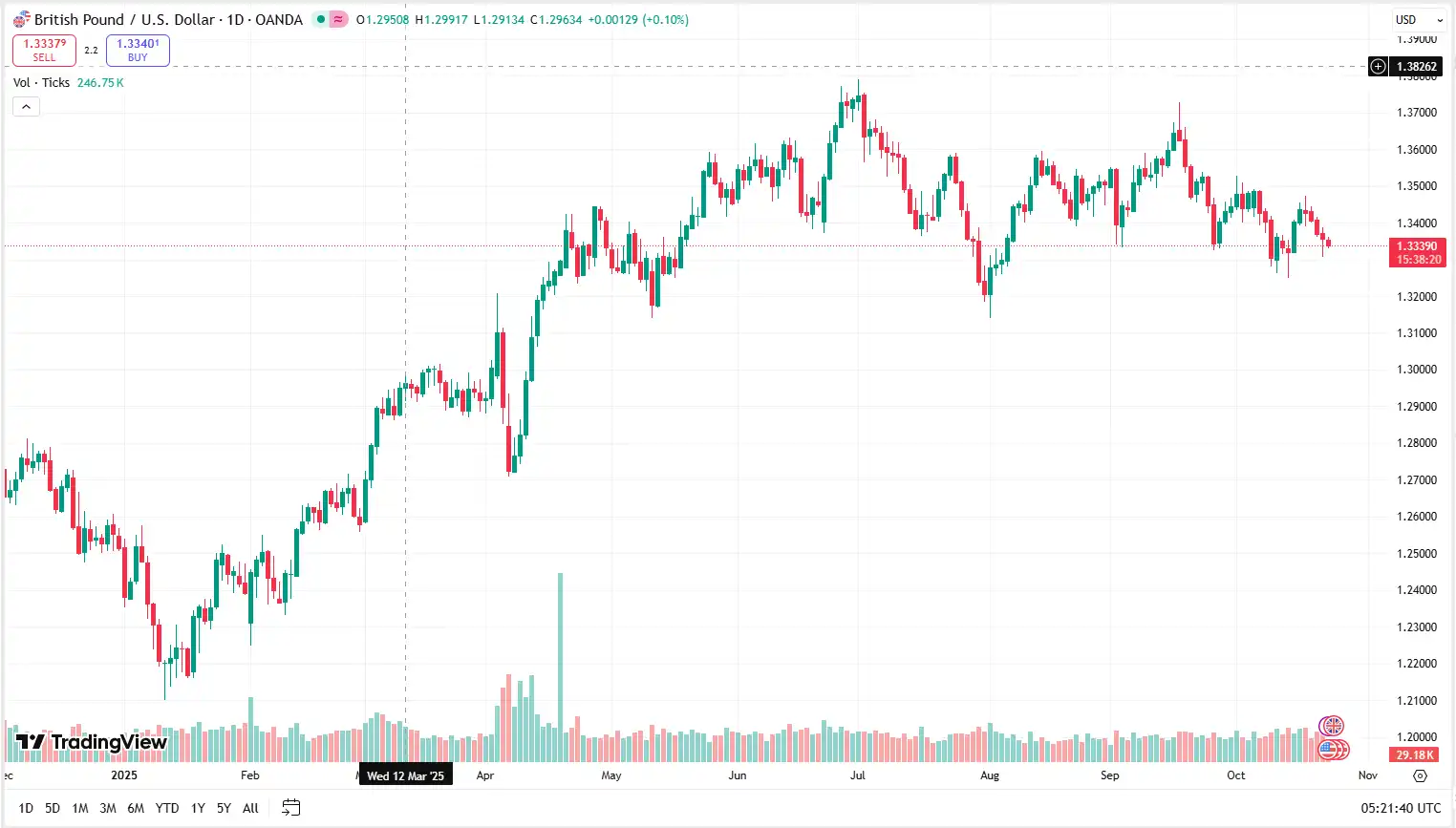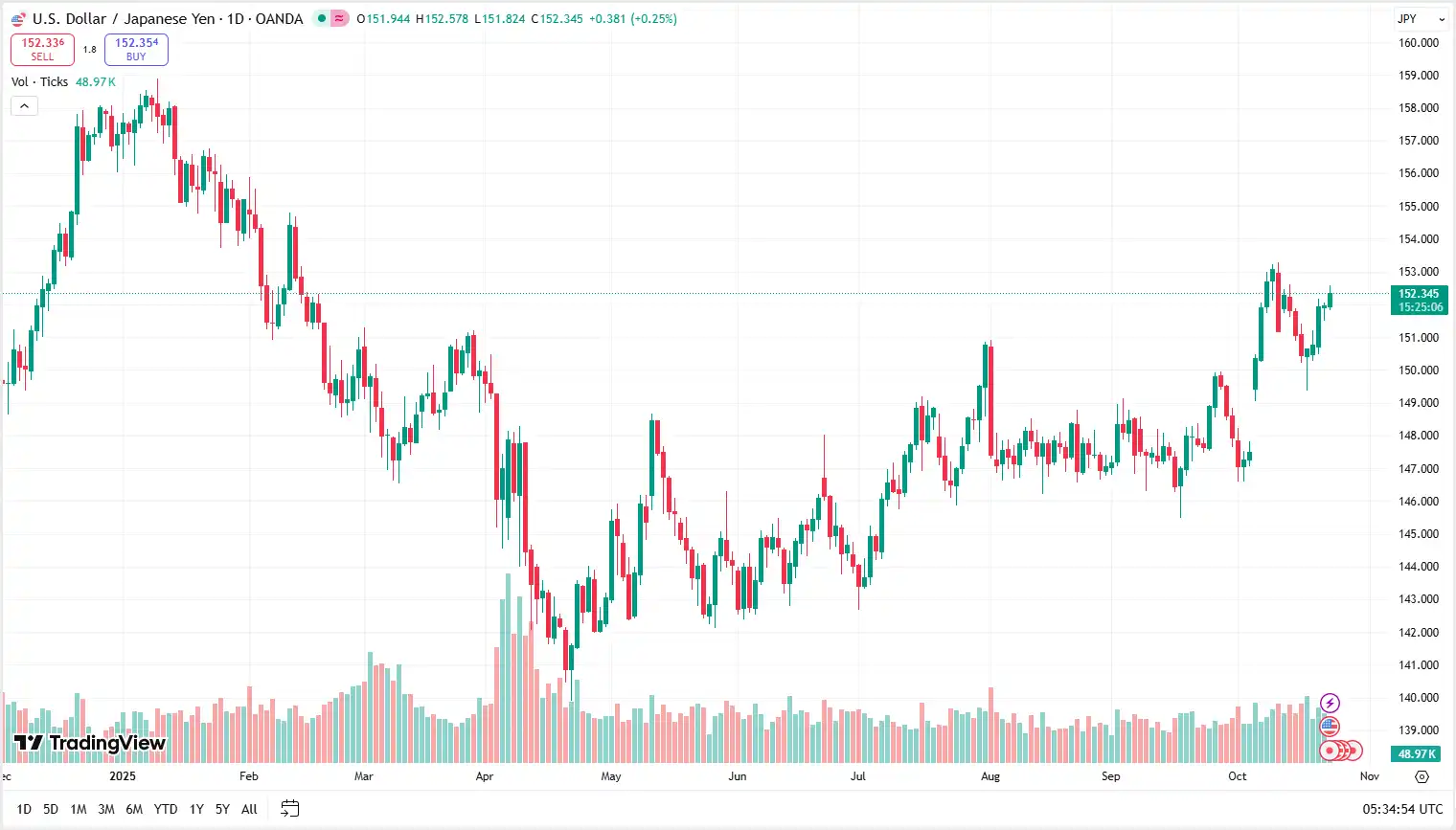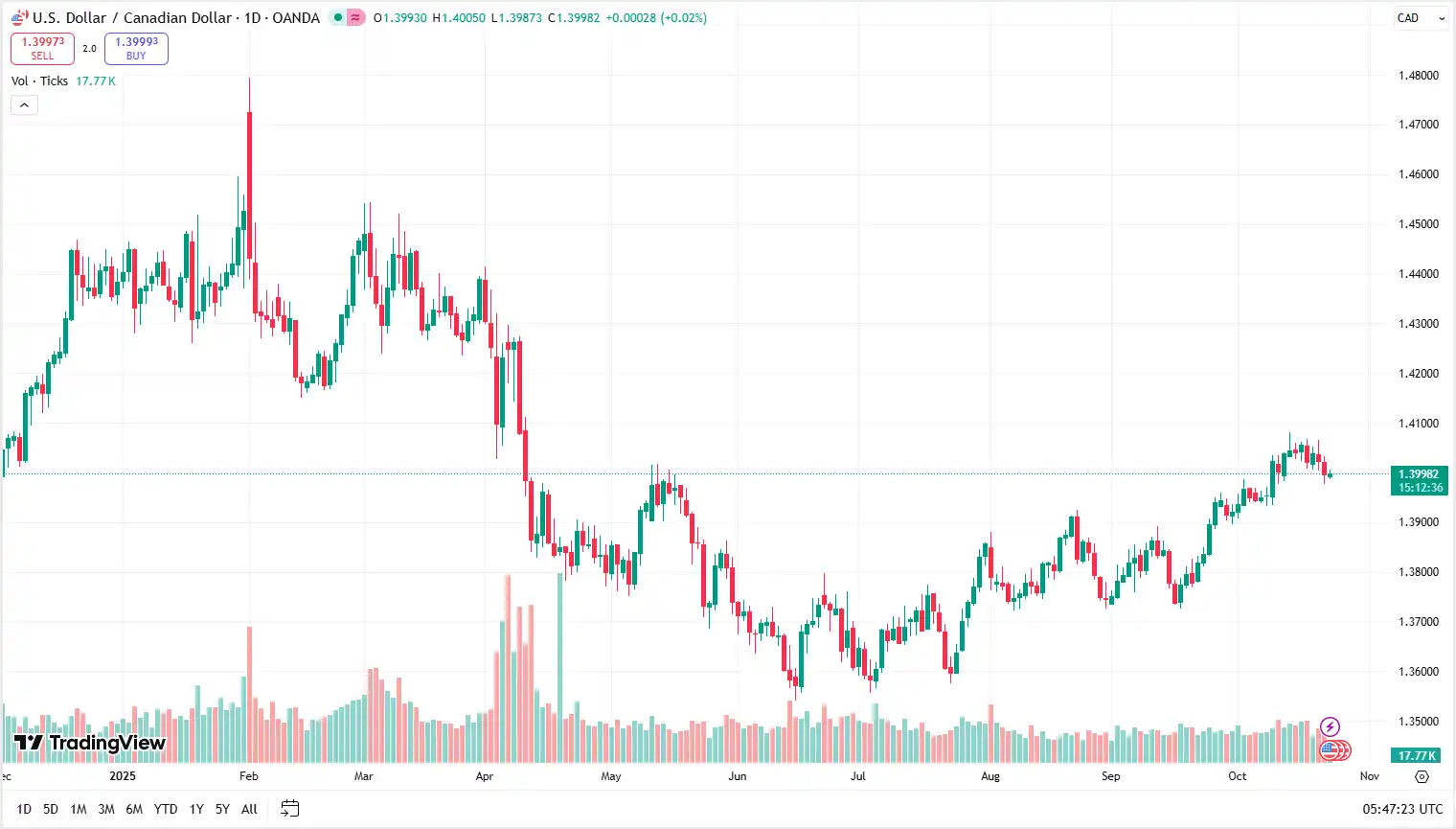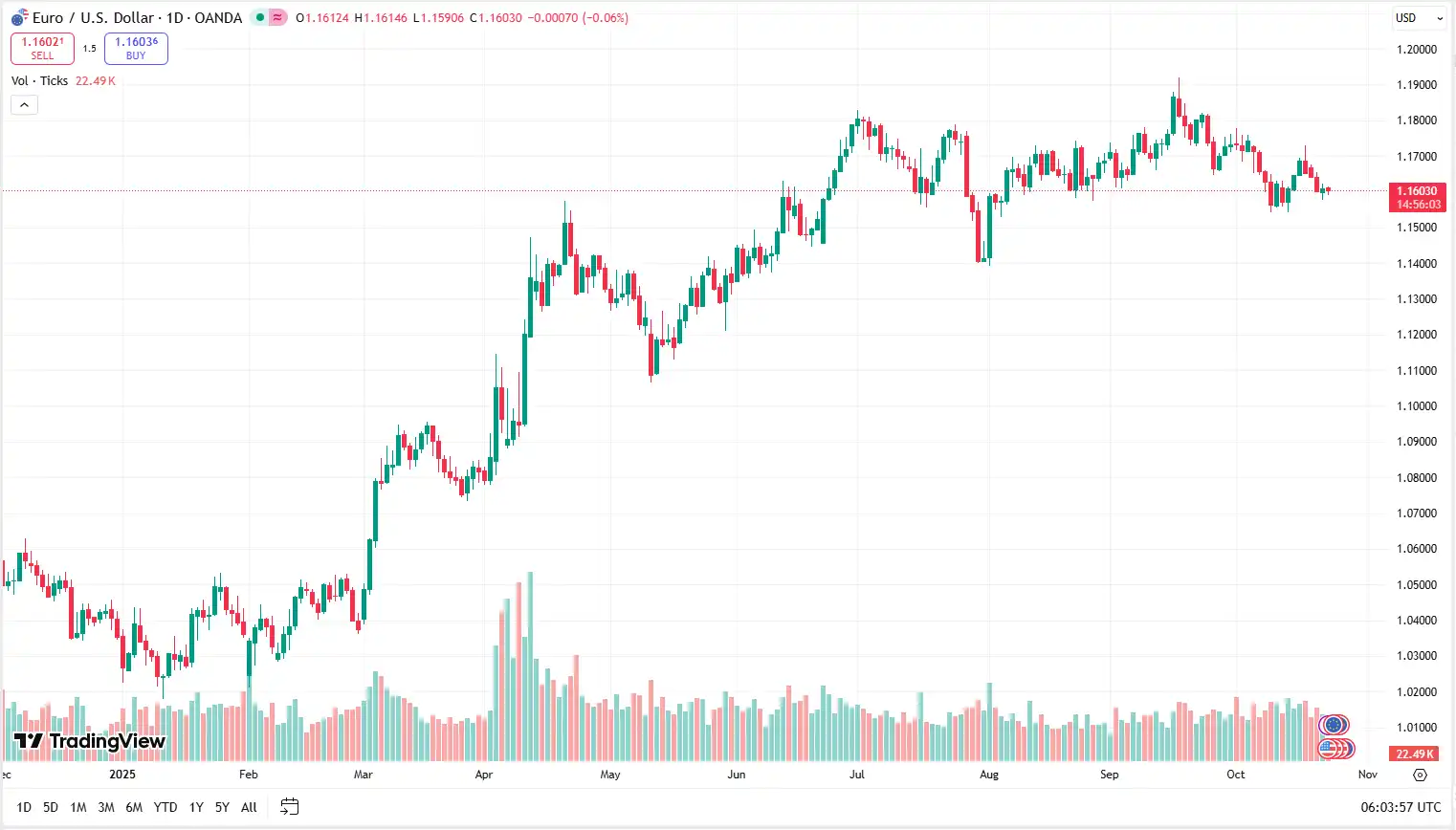GBP/USD continued its downward trajectory for the fifth consecutive session and traded near 1.3340[1] in Thursday’s Asian session. The pair is believed to be under pressure with the US dollar supported by increased risk aversion as investors act cautiously before the key US inflation data[2] due on Friday. The current US government shutdown[3] coupled with the related data blackout has further negatively impacted market sentiment, which has seen traders turn to the Greenback as a means of safety.
Market reports indicate that the attractiveness of the dollar is also boosted by renewed hopes of positive developments in US-China trade relations[4]. President Donald Trump issued statements to the effect that he is optimistic that he will enter into several agreements with Chinese President Xi Jinping when they meet in South Korea, and this has boosted the demand of the US dollar. Conversely, the CME FedWatch Tool indicates that markets are already forecasting a 97%[5] chance of a Fed rate reduction in October and another move is likely to occur in December. These expectations suggest that there is a long-term worry regarding the growth momentum of the US even in the face of a temporarily stronger dollar.
Market reports indicate that in the UK, the pound slumped drastically after Consumer Price Index (CPI)[6] results which were softer than expected in September. CPI rose 3.8% YoY, lower than the 4.0% forecast in the market and the core CPI fell to 3.5% compared to 3.6%. The figures support forecasts that the Bank of England (BoE)[7] could hold a tight policy amid the signs of decelerating inflation and weak domestic demand.
Analysts[8] suggest that in the immediate future, the two are susceptible below the 1.3400 level, and the short-term bias is leaner to the negative side as traders await the next round of US inflation data to provide new direction. An impressive print may further make the US dollar[9] stronger, whereas disappointing data may provide little relief to the Pound in the face of ongoing macroeconomic headwinds.

USD/JPY Extends Rally Amid Yen Weakness Outlook
USD/JPY continued its upward momentum for the fifth consecutive session and traded near 152.50[10] in Thursday’s Asian session. The continued rise is thought to be indicative of ongoing vulnerability of the Japanese yen due to hopes that the new Prime Minister, Sanae Takaichi[11], would focus on expansionary fiscal policies coupled with the accommodative monetary policy by the Bank of Japan (BoJ). The market participants expect the BoJ to keep its present policy settings at the upcoming meeting, and it is increasingly expected that the next rise in the rate will be postponed to early 2025.
Market commentators[12] indicate that the weakness of the yen is also related to the news that the administration of Takiichi might announce a massive stimulus package in the coming month that can be even more significant than what was announced last year JPY 13.9 trillion. This would strengthen the fiscal support system of Japan, compromising the value of the Yen as investors will find other more profitable returns. Conversely, the US dollar[13] is generally supported by better risk sentiment and hope of new US-China trade talks, whereby US President Donald Trump noted that a number of bilateral deals are being made with Chinese President Xi Jinping.
Market commentators[14] point out that the potential of the pair has been limited on the upside due to the presence of head winds by a long-term US government shutdown on the greenback. Key economic releases such as Nonfarm Payrolls (NFP) have been delayed by the disruption, and this makes the outlook of the policy of the Federal Reserve (Fed) data-cantered[15]. The absence of new macroeconomic indicators can make the volatility worse, especially when investor mood changes in response to uncertainty about the policy.
CME FedWatch Tool[16] indicated that markets are currently pricing a 97% Fed rate cut in October and an additional 96% in December. These assumptions imply that, although there is a positive momentum in USD/JPY in the near-term, there are risks in the medium-term. The weakening of US economic[17] fundamentals and expectations of a dovish Fed may ultimately curb the upward level of the pair, keeping traders on guard at high levels.

USD/CAD Slips as Oil Strengthens Loonie
The USD/CAD pair edged lower to trade around 1.3990[18] in Thursday's early Asian trading, extending modest losses as the Canadian dollar found support from higher crude oil prices. The Loonie[19] is believed to have gained due to a sudden increase in oil, which is the biggest export of Canada, when the US sanctioned key Russian energy companies, which propelled the crude to close to a 2-week high. The action strengthened the demand of the commodity-based Canadian dollar[20] and curtailed the upside potential of the Greenback.
Market reports[21] point out that the general mood is still skeptical before major economic reports are released later in the day. The Canadian Retail Sales[22] are expected to increase by 1.0% per month in August and core Retail Sales, which exclude autos, is anticipated to increase by 1.2%. Better-than-anticipated figures may solidify the hopes surrounding domestic demand and add more support to the Canadian currency. Meanwhile, the US Kansas Fed Manufacturing Activity index[23] might give new information regarding the well being of the US industrial sector, however, a general uncertainty of the economy is still looming over the horizon as the government shutdown persists.
Market commentators[24] suggest that in the policy aspect, the US dollar is still burdened by expectations of additional Fed rate cuts. It is well anticipated by market participants that both October and December will see a 25-basis-point cut in the funds, and the Fed funds[25] futures are pricing in 97% likelihood of that happening, LSEG data show. The blacklisting of major US data releases has made the Fed more difficult in gauging underlying economic dynamics, where a dovish tilt constrains the recovery capacity of the Greenback.
Analysts[26] indicate that within a short period of time, the two may be susceptible to downward forces against high oil prices and robust Canadian statistics. Nevertheless, US-Canada trade tensions and declining trade growth across the globe are medium-term threats to the strength of the Canadian dollar[27], which may limit further losses in the pair over the next weeks.

EUR/USD Slips as Dollar Strengthens Ahead
The EUR/USD pair edged lower to trade around 1.1600[28] in Thursday’s Asian session, as the US dollar regained ground following its recent corrective move. The dollar strength is thought to have driven the US dollar Index (DXY)[29] toward the 99.00 level, which indicated a slight recovery in greenback demand. The small dip of the pair is a wider market hesitation, and traders are repositioning before the major US economic data are released later in the day.
Market commentators[30] note that the dollar is bouncing back even though there remains concern of US-China trade tensions, following reports that Washington would limit software-based exports to Beijing. The suggested curbs, as a reaction to the Chinese export controls[31] on rare earth minerals, have the potential to cause a renewed trade uncertainty and reduce risk sentiment in the world. Nonetheless, the euro is weakened by the safe-haven flows and short-term profit-taking, which support the dollar[32], restricting its capacity to appreciate.
Market reports[33] point out that in the domestic front, investor attention shifts toward the September US Consumer Price Index (CPI) data. The release would provide a new understanding of inflation trends and potentially influence the expectations of the future of the Fed policy. CME FedWatch Tool[34] market pricing suggests increasing confidence that the Fed will provide additional rate cuts in its remaining two meetings of this year. Nevertheless, the US data[35] is weaker as the government shutdown is still underway, and this development has increased the level of uncertainty, which keeps the volatility high in key currency pairs.
Analysts[36] point out that as viewed by the eurozone, the EUR is widely stable, underpinned by the anticipation that the European Central Bank (ECB) will maintain its Deposit Facility rate at 2% until 2026. Nevertheless, any dovish move[37] at the next ECB meeting on October 30 would put pressure on the single currency and EUR/USD would be exposed below 1.1600 in the short-run, but there is a downside bias in the long-term risks.

Stay Ahead in the Currency Game
Whether you're a daily FX trader or handle international transactions regularly, our 'Currency Pulse' newsletter delivers the news you need to make more informed decisions. Receive concise updates and in-depth insights directly in your LinkedIn feed.
Subscribe to 'Currency Pulse' now and never miss a beat in the currency markets!
Ready to act on today’s insights? Get a free quote or give us a call on: +44 (0)20 7740 0000 to connect with a dedicated portfolio manager for tailored support.
Important Disclaimer: This blog is for informational purposes only and should not be considered financial advice. Currency Solutions does not take into account the investment objectives, financial situation, or specific needs of any individual readers. We do not endorse or recommend any specific financial strategies, products, or services mentioned in this content. All information is provided “as is” without any representations or warranties, express or implied, regarding its accuracy, completeness, or timeliness.




